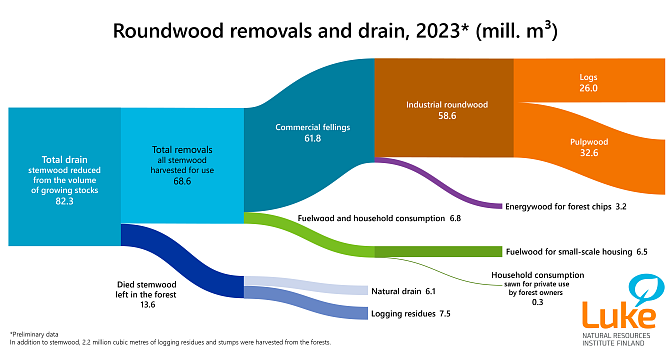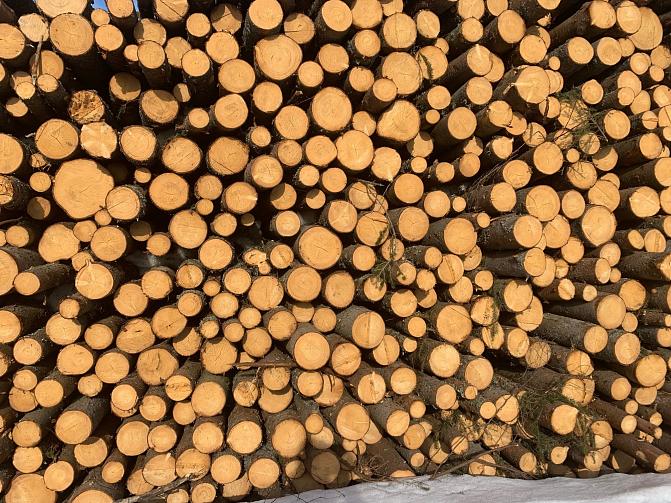Removals decreased to 69 million cubic metres in 2023
Roundwood removals decreased last year, totalling 69 million cubic metres. Log removals decreased by nine and pulpwood removals by eight per cent. At the same time, total drain fell to 82 million cubic metres. As the annual increment of the growing stock was higher than removals, the total volume increased by more than 20 million cubic metres.
According to the Natural Resources Institute Finland’s (Luke) preliminary data, log and pulpwood removals totalled 58.9 million cubic metres in 2023, showing a decrease of eight per cent from the previous year. Logs and pulpwood are mainly used in the forest industry, while less than half a million cubic metres is consumed as raw material for sawn goods used by forest owners. The total volume of roundwood harvested for forest chips and fuelwood for use in small-scale housing decreased by ten per cent to 9.7 million cubic metres.
“Industrial roundwood removals followed the previous year’s rate during the first half of last year, after which they fell significantly as demand for forest industry products decreased. The total volume of roundwood felled for the production of forest industry products and use as energy – roundwood removals – decreased by roughly seven million cubic metres to 69 million cubic metres. This marked a decrease of nine per cent from last year and eight per cent from the previous five-year period,” says Jukka Torvelainen, Senior Statistician at Luke.

Industrial roundwood removals fell
Log and pulpwood removals for industrial use and exports totalled 58.6 million cubic metres, decreasing by 5.4 million cubic metres from last year and being nine per cent below the average level of the previous five years.
“The last time industrial roundwood removals were below 60 million cubic metres was in 2020 and before that in 2015,” says Tiina Sauvula-Seppälä, Senior Statistician at Luke.
In non-industrial private forests, roundwood removals decreased by more than a tenth from the year before. The state and companies increased the felling of pine logs and softwood pulpwood which in turn increased log and pulpwood removals by three per cent in forests owned by them.
The largest drop in spruce log removals
Log removals totalled 26.0 million cubic metres, down by ten per cent from the previous year. Spruce log removals dropped by 14 per cent, while pine log removals decreased only by three per cent.
Pulpwood removals decreased by eight per cent to 32.6 million cubic metres. Pine pulpwood removals of 15.1 million cubic metres marked the lowest volume since 2012. Hardwood pulpwood removals did not increase as expected, but remained at 8.0 million cubic metres.
Removals did not decrease in three regions
This was the first time preliminary data on removals were published by region. Northern Savonia and North Karelia recorded the highest roundwood removals, slightly more than six million cubic metres each. Industrial roundwood removals remained unchanged in the regions of Lapland, Kainuu and Central Ostrobothnia. In eight regions, removals fell by more than ten per cent.
Energywood removals decreased by a fifth
Energywood removals for heat and power plants totalled 5.5 million cubic metres, of which roundwood, i.e. whole trees and pruned stems, accounted for 3.2 million and logging residues and stumps for 2.2 million cubic metres.
“Energywood removals decreased by a fifth as the volume of delimbed stems and whole trees fell by more than a million cubic metres. This can partly be explained by fiercer competition over small-diameter trees and partly by rising prices. However, preliminary data about energywood are not as accurate as those regarding industrial roundwood, and any changes will be specified later in spring,” Sauvula-Seppälä says.

96 per cent of the felling potential used in Southern Finland
Luke estimates the sustained yield of commercial timber and energywood harvested from our forests based on the National Forest Inventory (NFI). In summer 2023, it was estimated to be an average of 79.8 million cubic metres of roundwood per year in 2019–2028.
“In 2023, removals were 11.2 million cubic metres below the estimated felling potential in the whole of Finland, with 86 per cent of the potential being used. Regional data will be specified later in spring, but based on the preliminary data, removals will remain below the estimated potential in all regions,” Torvelainen says.
Removals show significant annual variation. Since 2019, Finland’s felling volumes have ranged annually between 86 and 96 per cent, covering an average of 92 per cent of the estimated sustained yield. Some four fifths of the potential have been felled in Finland’s three northernmost regions, while the corresponding figure is 96 per cent in the regions to the south of this area.
The difference between the annual increment and total drain increased
Last year, roundwood removals for use totalled 68.6 million cubic metres. In addition, some eight million cubic metres of stemwood of logging residues and six million cubic metres of naturally died stemwood remained in forests. The resulting total drain decreased by seven million cubic metres from the previous year to 82.3 million cubic metres. This was eight per cent lower than last year and seven per cent below the average level of the previous five years.
“Last year, felling, silviculture and natural drain reduced the volume of the growing stock by 82 million cubic metres. However, as the annual increment increased the volume of standing trees by 104 million cubic metres, the total volume of the growing stock increased by 21 million cubic metres,” says Torvelainen.
Background to the statistics
Luke collects and publishes data on commercial felling by month and calendar year. Other items used in the calculation of total roundwood removals and drain are identified through separate surveys or in conjunction with the National Forest Inventories (NFI).
The volume of wood sawn by forest owners for their private use was previously identified for 2010, and the volume of fuelwood consumed in small-scale housing for the 2016/2017 heating season.
Preliminary data about annual removals and drain are published in February and final regional data in April. The preliminary data for 2023 also include regional data for the first time.





